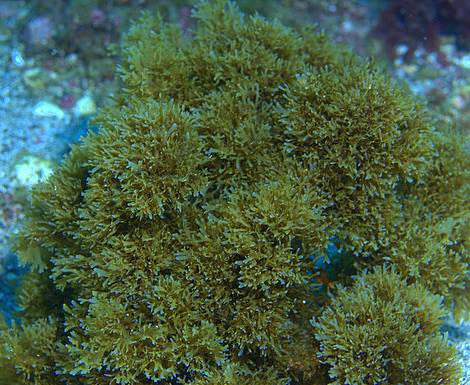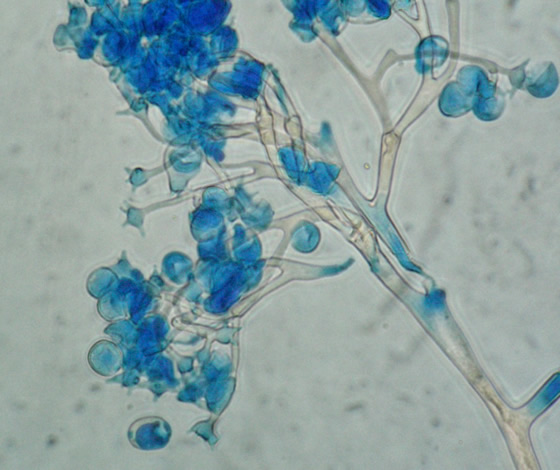 |
| Heterokonts |
Heterokonts are a group of closely related phyla with flagella in pairs, one long and one short. They include oomycetes, chrysophytes, diatoms, and brown algae.
The term “heterokont” refers either to the flagellar arrangement of biflagellate cells in which the two flagella differ in length (as in anisokonts), type of motion, or ornamentation, or to those organisms (and organisms evolutionarily derived from such lineages) in which biflagellate cells with heterokont flagella are produced at some point during their life cycle.
The most common heterokont flagellar arrangement consists of a posteriorly directed whiplash flagellum and an anteriorly directed tinsel flagellum. The tubular tinsel flagellum characteristically bears two rows of stiff, glycoproteinaceous, tripartite hairs previously referred to as mastigonemes but now increasingly referred to as stramenopili. Such organisms are often referred to as stramenopiles.
  |
Although alternative heterokont arrangements in which two nontinsel flagella differ are found in other unrelated groups (such as the dinoflagellates or endoparasitic slime molds (plasmodiophorids), these organisms are unrelated to the stramenopila bearing (stramenopilous) heterokonts and are not generally referred to as heterokont genera.
Evolutionary Relationships
Stramenopilous heterokonts are a diverse group of protists containing tubulocristate mitochondria that are phylogenetically related by the presence of stramenopili (usually associated with the tinsel flagellum, otherwise on the cell surface).
Their precise relationship to other eukaryotes is poorly defined, but they clearly represent one of the early independent lineages associated with the crown eukaryotic radiation (which included plant, animal, and fungal lineages). The inclusion of major autotrophic (many of the algal forms contain chlorophyll a and c) and heterotrophic groups has led to a conflicting nomenclature.
The initially proposed kingdom Chromista presumes heterotrophs were derived from ancestral autotrophs, while the more recently proposed kingdom Stramenopila implies a heterotrophic ancestor, with autotrophs as the derived forms. Relationships between the autotrophic and heterotrophic taxa, however, are still not clearly resolved.
Heterotrophic heterokonts (heterokont fungi) include the fungal-like oomycetes, hyphochytriomycetes, thraustochytrids, and labyrinthulids. Autotrophic heterokonts (heterokont algae) include the chromophytic algal groups, represented by diatoms, brown algae, golden algae, and yellow-green algae.
Oomycetes
Often referred to as the oomycetous water molds, the oomycetes (Peronosporomycetes) form the largest and most ubiquitous group of heterotrophic stramenopiles. Free-living forms occupy diverse ecological niches ranging from freshwater and marine to terrestrial environments. Both terrestrial and marine forms include saprophytic and obligately, or facultatively, parasitic genera.
Hosts include a range of nematodes, arthropods, molluscans, algae, and plants. Several of the plant pathogens have impacted the cultural and economic history of humans. These include the causative agents for a variety of root rots, downy mildews, white rusts, and late blights.
Downy mildews of grapes (Plasmopara) and tobacco (Peronospora) were responsible for the near-decimation of the French wine industry and the Cuban tobacco industry in the late 1870’s and the 1980’s, respectively.
Similarly, Phytophthora infestans, the causative agent of potato late blight, was responsible for the Irish Potato Famine of the mid-1840’s and, during World War I, for the starvation of German civilians in 1915-1916.
Diatoms
Diatoms are the most diverse and abundant of the photosynthetic heterokonts. They are among the most important aquatic photosynthesizers and are probably the most numerous aquatic eukaryotes.
Found as single cells or chains of cells in marine, freshwater, and terrestrial environments, they often dominate the phytoplankton of nutrient-rich waters. The cells are enclosed in a highly ornamented silica box (frustule). These frustules are of either the centric type, with apparent radial symmetry, or of the pennate type, with apparent bilateral symmetry.
The chloroplasts of diatoms commonly contain the carotenoid fucoxanthin as an accessory photosynthetic pigment. A single tinsel flagellum, but no whiplash flagellum, is evident in sperm cells of those species in which sexual reproduction is known.
A few species have been associated with fish kills, while some species of Pseudo-nitzschia produce the toxin domoic acid, responsible for amnesiac shellfish poisoning in humans. In the newer taxonomic systems they are included in the phylum Ochrophyta rather than the phylum Bacillariophyta.
Chrysophytes
Chrysophytes are often referred to as the golden algae because of the dominance of the pigment fucoxanthin. The phylum Chrysophyta had previously included a loosely related assemblage of algal forms, such as haptophytes, synurophytes, and diatoms.
The term “chrysophycean,” referring to the class Chrysophyceae of the Ochrophyta, now more appropriately includes those chrysophytes phylogenetically related by ultrastructural, pigment, and molecular analyses.
These chrysophyceans are unified by the use of chlorophylls a, c1, and c2, the accessory pigments fucoxanthin and violaxanthin, and a silica-walled resting stage (stomatocyst, stomatopore). They are present as unicellular or colonial forms. Representative genera include Ochromonas, Dinobryon, and Chrysocapsa.
Brown Algae
 |
| Brown algae |
The brown algae (phaeophyceans) are primarily marine algae and range in linear length from microscopic filaments to several meters (up to 60 meters and 300 kilograms in the giant kelp Macrocsystis pyrifera). Many species exhibit specialized organs and tissues such as leaflike blades, rootlike holdfasts, and cells resembling sieve elements of higher land plants.
Like other ochrophytes, they have two forms of chlorophyll c as well as fucoxanthin and violaxanthin. Species of Laminaria, Fucus, and Macrocystis are primary sources of alginates used in a variety of industrial applications, from the textile industry (prints) to food processing (as a thickening agent).
